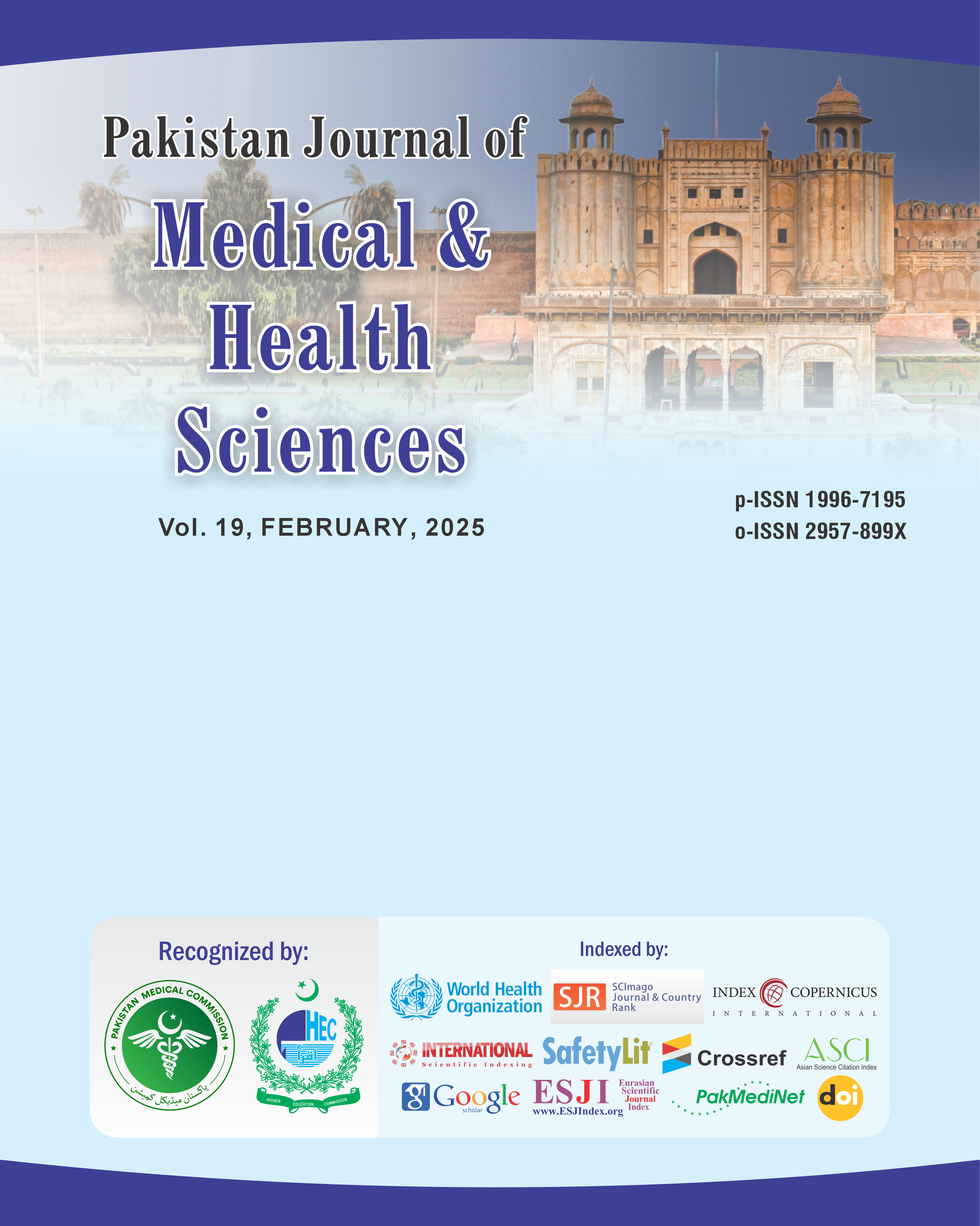Comparative Evaluation of Dietary Patterns and Nutrient Intake in Obese and Non-Obese Adults of Lahore
DOI:
https://doi.org/10.53350/pjmhs02025192.5Keywords:
Lifestyle modification, non-obese, nutrients, caloric distribution.Abstract
Background: Obesity is a major public health problem worldwide and especially in an urban setting such as Lahore where dietary transition is driving health outcome. Sometimes, the development of obesity is attributed to nutritional imbalances. Nevertheless, there are limited comparative data on dietary patterns of obese and non-obese adults in Pakistan.
Aim: To assess and compare dietary patterns, nutrient intake and caloric distribution between obese and non- obese adults living in Lahore to identify dietary risk factors which are modifiable in order to reduce the risk of obesity.
Methodology: Comparative study was carried out on 100 adult participants (50 obese and 50 non-obese) aged 20 to 50 years from urban health clinics and community centers in Lahore. Records were made of anthropometric measurements (BMI, waist circumference). The daily nutrient intake, macronutrient distribution, and adherence to balanced diet were assessed by a validated food frequency questionnaire and 24 hour dietary recall. Fasting glucose and lipid profile were also studied.
Results: Mean ± SD daily calories consumed were significantly greater for obese (2,630 ± 340 kcal) than non-obese (1,980 ± 290 kcal, p < 0.001). The obese group had excessively high saturated fat and sugar intakes and very low fiber and vegetable intakes. Furthermore, the non-obese group had a higher adherence to balanced dietary guidelines, higher whole grain, fruit and lean protein intake. Also, there was a positive correlation between total caloric intake and BMI (r = 0.72).
Conclusion: Significant differences in dietary pattern and intake of nutrients are shown in obese and non-obese adults in Lahore. Obesity is defined by poor dietary habits such as high caloric intake, low fiber consumption, imbalanced macronutrient ratios. These findings emphasize the importance of implementing community based nutritional interventions and public health strategies on dietary education and lifestyle modification.
References
World Health Organization. Obesity and overweight. WHO Fact Sheet. 2023.
Malik VS, Willett WC, Hu FB. Global obesity: trends, risk factors and policy implications. Nat Rev Endocrinol. 2022;18(1):12–27.
Ng M, Fleming T, Robinson M, et al. Global, regional, and national prevalence of overweight and obesity in children and adults during 1980–2020: a systematic analysis. Lancet. 2021;398(10299):982–92.
Afzal M, Khattak S, Rehman S, et al. Urban dietary transitions and their impact on health in Pakistan. Int J Public Health. 2022;67:1604589.
Bhatti A, Siddiqui N, Yaqoob M. Association between dietary fat intake and obesity in urban Pakistani adults. J Pak Med Assoc. 2022;72(4):631–6.
Ahmad S, Ullah K, Farooq U. Comparative dietary analysis of obese and non-obese individuals in South Punjab. DMLS. 2023;4(1):34–40.
Iqbal H, Shafique Z, Khalid M. Urban lifestyle, diet and risk of metabolic syndrome in Pakistani adults: A cross-sectional study. DMLS. 2023;4(2):12–18.
Mozaffarian D, Rosenberg I, Uauy R. History of modern nutrition science—implications for current research, dietary guidelines, and food policy. BMJ. 2023;382:e071328.
Afshin A, Sur PJ, Fay KA, et al. Health effects of dietary risks in 195 countries, 1990–2019: a systematic analysis. Lancet. 2020;395(10220):1958–72.
Hussain A, Ali I, Fatima A. Dietary fiber and its role in controlling glycemic and lipid profiles: A South Asian perspective. J ClinNutrMetab. 2021;6(3):144–50.
GBD 2019 Risk Factors Collaborators. Global burden of 87 risk factors in 204 countries and territories, 1990–2019. Lancet. 2020;396(10258):1223–49.
Monteiro CA, Cannon G, Moubarac JC, et al. Ultra-processed foods: what they are and how to identify them. Public Health Nutr. 2023;26(1):1–6.
Ijaz M, Haider Z, Nawaz H. Association between saturated fat intake and cardiovascular risk in Pakistani adults. Pak Heart J. 2022;55(2):129–35.
Rehman A, Shahid M, Khan N. Effect of macronutrient imbalance on obesity-related comorbidities in young adults. BMC Nutr. 2021;7(1):23.
Singh K, Misra A, Srivastava S. Diet, obesity and diabetes: A South Asian perspective. DiabetolMetabSyndr. 2022;14:6.
Bano R, Qureshi MA, Zaman H. Role of balanced diet in controlling urban obesity: A controlled trial. J Nutr Sci. 2023;12:e20.
Basit A, Fawwad A, Siddiqui SA. Glycemic control and dietary habits among type 2 diabetics in Karachi. Diabetol Int. 2022;13(4):513–20.
Khan RM, Awan FR. Interventions to reduce dietary risks for obesity in Pakistan: A systematic review. Pak J Med Sci. 2021;37(7):1892–9.
Ali S, Farooqi M, Khan AA. Sociocultural determinants of food choice and diet quality in urban Pakistan. Int J Environ Res Public Health. 2023;20(6):4893.
Misra A, Shrivastava U. Obesity and dyslipidemia in South Asians. Nutrients. 2022;14(5):1138.
Downloads
How to Cite
Issue
Section
License
Copyright (c) 2025 MUHAMMAD NASIR SHAHBAZ, ARSLAN SHUJA, MUZNA KASHIF, MAMOONA SHUJA

This work is licensed under a Creative Commons Attribution 4.0 International License.


